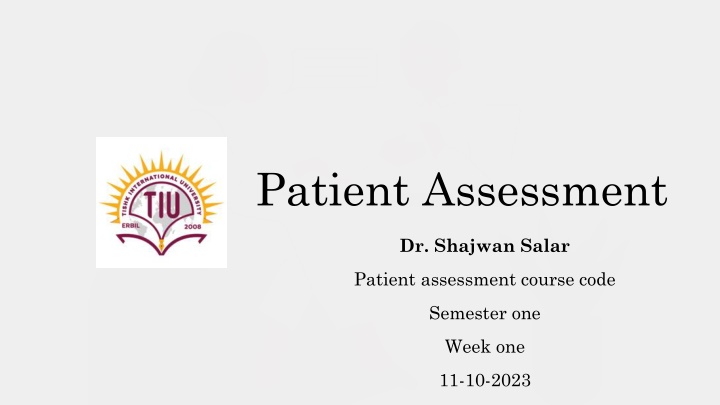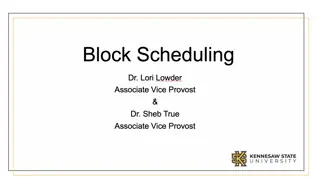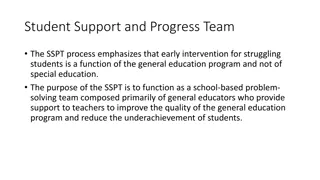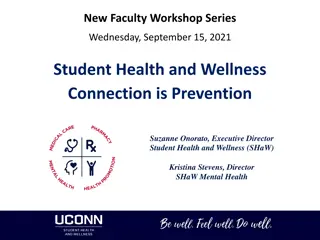
Comprehensive Guide to Patient Assessment for Pharmacists
"Learn about the basics, importance, and practical application of patient assessment in pharmacists' daily practice. Understand the role in improving clinical outcomes, communication skills, and legal responsibilities. Enhance skills in drug dispensing, interactions, and patient care for better healthcare delivery."
Download Presentation

Please find below an Image/Link to download the presentation.
The content on the website is provided AS IS for your information and personal use only. It may not be sold, licensed, or shared on other websites without obtaining consent from the author. If you encounter any issues during the download, it is possible that the publisher has removed the file from their server.
You are allowed to download the files provided on this website for personal or commercial use, subject to the condition that they are used lawfully. All files are the property of their respective owners.
The content on the website is provided AS IS for your information and personal use only. It may not be sold, licensed, or shared on other websites without obtaining consent from the author.
E N D
Presentation Transcript
Patient Assessment Dr. Shajwan Salar Patient assessment course code Semester one Week one 11-10-2023
Patient Assessment And Communication Dr. Shajwan Salar Nanakali BPharm, MPH (Global Public Health)
Instructions and student evaluation Weekly hospital visits and ward orientation. Patient s assessment and history taking. Class presentations and case studies Group case scenarios and discussions Follow dress code and professional positive attitude with staff and colleagues Complete required assessments (forms, reports, quizzes etc) as per required
Learning Outcomes Understand the basics and importance of patient assessment Understand the role of pharmacists in providing patient assessment Understand the role of pharmacists in providing patient-centered care. Improve clinical health outcomes and patient care through decreasing medication-related adverse events. Develop and improve engagement and communication skills. Utilize legal, ethical, and professional responsibilities as clinical and community pharmacists. Utilize skills in drug dispensation, drug interactions, patient adherence, compliance, and long-term follow-up.
Patient assessment includes gathering relevant information through dialogue with the patient, reviewing the patient profile and using that information to identify drug therapy problems or other issues that could affect health outcomes.
The four elements of patient assessment 1. Knowledge of the characteristic patterns of signs and symptoms 2. Evaluative or diagnostic criteria. 3. Patient history. 4. Objective data: physical examination, laboratory test results, and medical imaging.
Patient assessment is an integral component of pharmacists day-to-day practice in community pharmacies, hospitals, and specialized practices. Acute illnesses to long-term care. Patient assessment involves an approach to assess adverse reactions, allergies, and drug-drug interactions. Chronic disease assessment and follow-up.
As pharmacy continues its rapid transition to a more patient-centered profession, patient assessment is one of the most important skill sets a pharmacist will use in daily clinical practice. For every prescription that is dispensed, pharmacists must ask whether the prescription is therapeutically appropriate. This includes gathering relevant information through dialogue with the patient, and creating, adjusting or reviewing the patient profile. Community pharmacists: shift from providing products to providing patient care services.
Pharmacist Roles That Require Patient Assessment Skills 1. Identifying potential drug-related problems. 2. Monitoring/managing patient drug therapy for chronic diseases. 3. Assess patients for self-care or referral 4. Counseling/educating patients about disease and drug therapy 5. Communicating effectively with other health professionals
Relevant important information, but not limited to: Allergies Medical conditions Lifestyle factors (e.g. smoking, nicotine use, cannabis use, caffeine, diet, alcohol, exercise) Other prescription medications, over-the-counter medication and natural health products Changes to the patient s health status Indication for medication
Medical history using SAMPLE mnemonic: Signs and Symptoms What can be seen? What is the patient complaining of? Allergies Do you have any allergies? Medications Are you taking any prescribed medication(s)? Pertinent History Do you have any i.e. cardiac problems / diabetes? Last oral intake What was the last time food or drink was consumed? Events leading up to... How and when did it occur? Has it occurred before?
Assessing complaints, signs and symptoms using OPQRST mnemonic: Onset Was onset of symptoms fast or slow? When did the pain start? Was it sudden or gradual? What were you doing when the pain started? Pain Quality What words would you use to describe your pain? Point to the area that hurts the most, where does it go from there? Radiates Use the PAINLOG as the determination of severity of pain levels or if PAINLOG not available verbally ask pain level e.g. on a scale of 0 - 10, 0 being no pain and 10 the worst pain imaginable, what is your pain level. Severity What treatment (if any) are you receiving from your doctor/hospital? What tablets (if any) have you been prescribed? Are you taking any other tablets? Treatment / Tablets
Q- What does the B in trauma assessment DCAP-BTLS stand for?






















